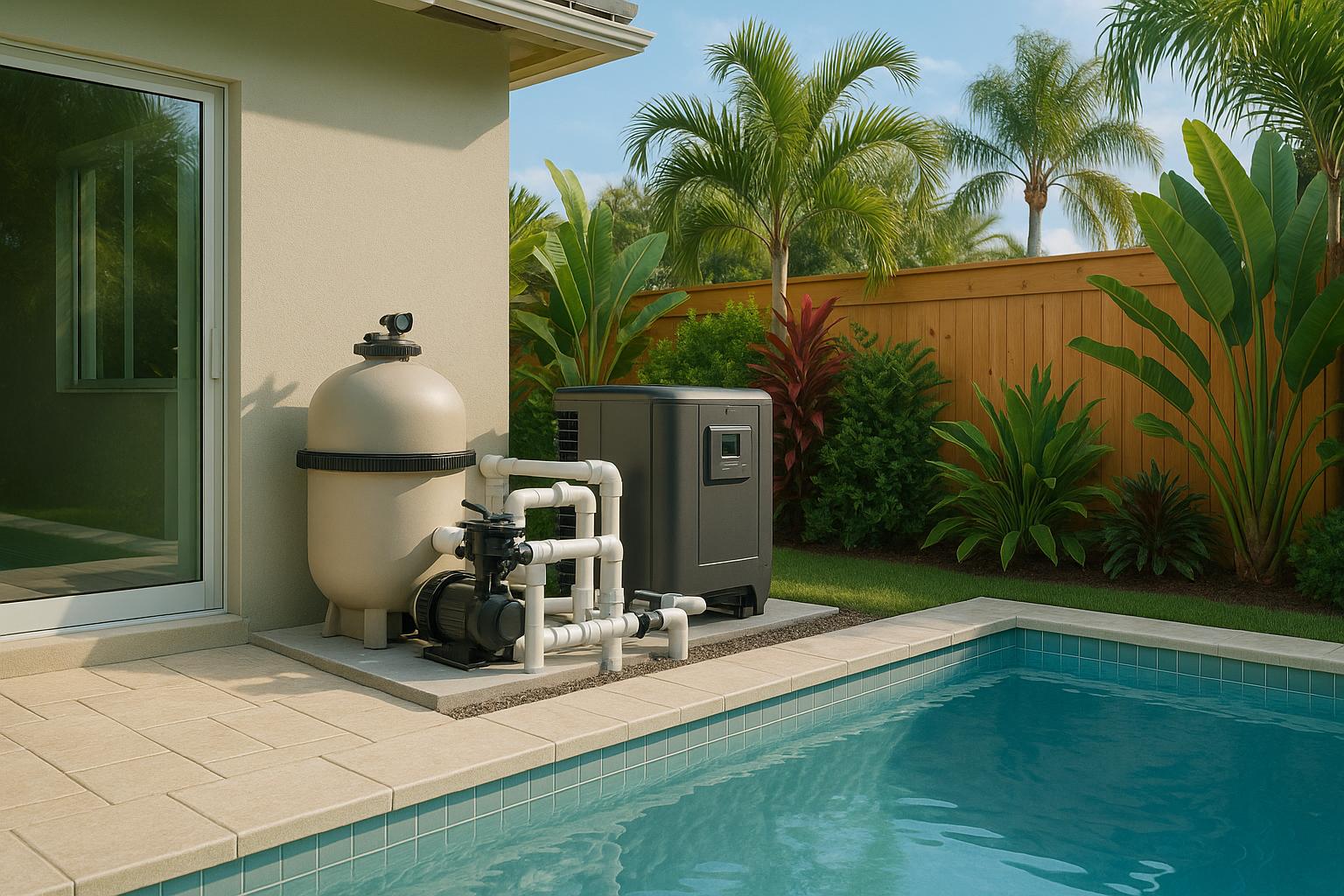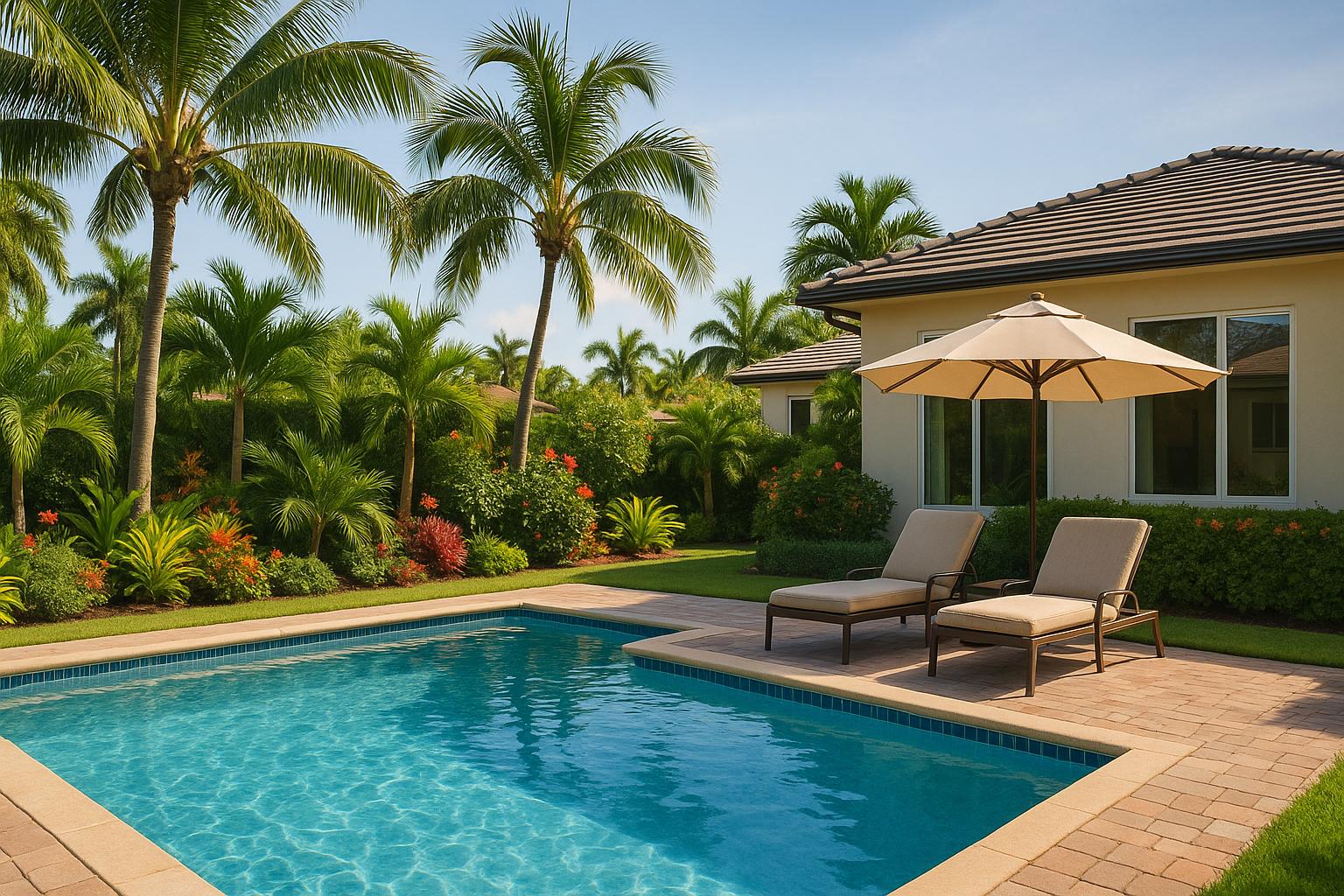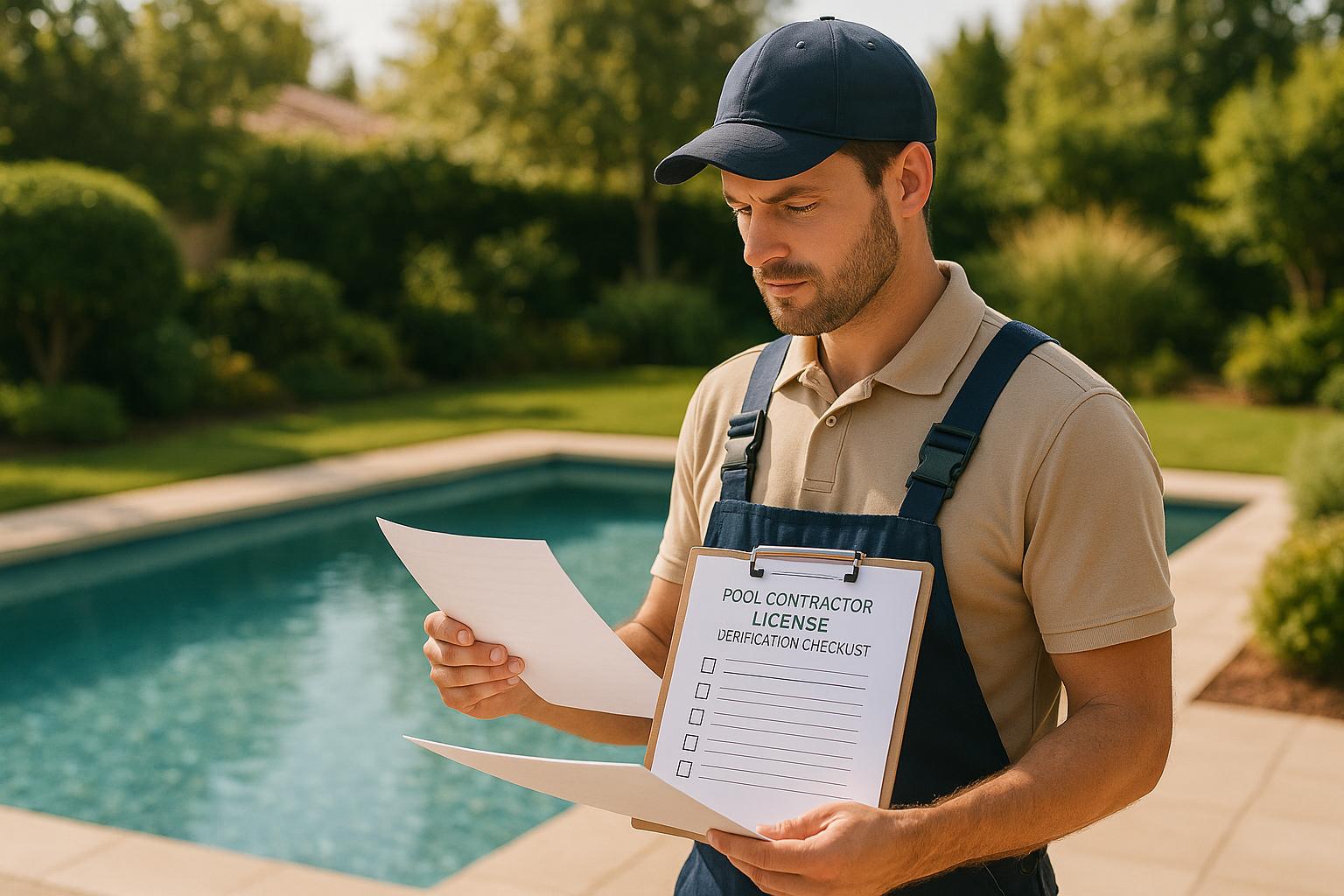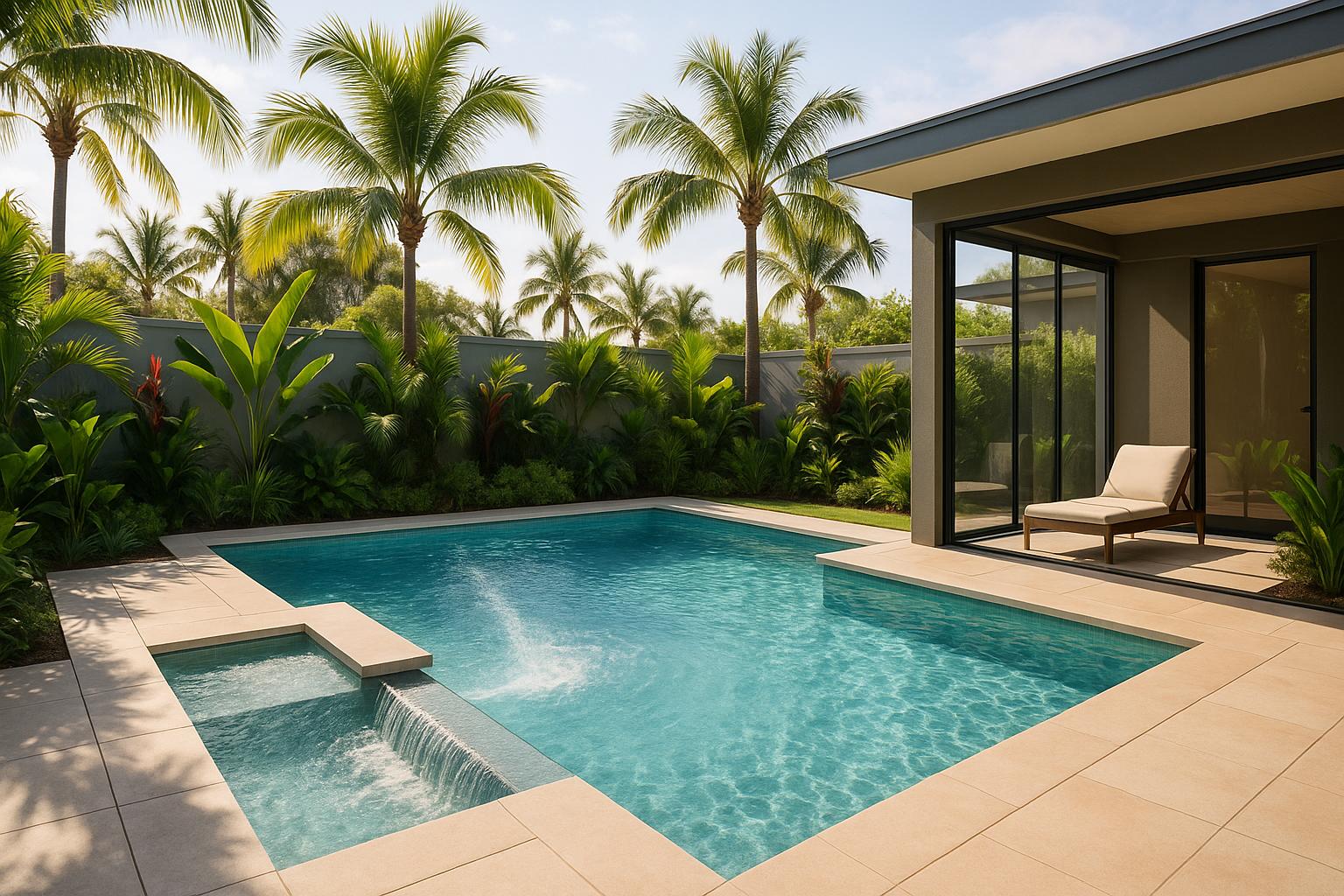Best Pool Features for Florida Climate
Florida’s climate demands pools built to handle intense heat, UV rays, high humidity, and hurricane risks. To ensure durability, comfort, and lower maintenance, here’s what you need to know:
- Heat-resistant materials like quartz-finished concrete and UV-resistant fiberglass prevent fading and cracking, while natural stones like travertine keep surfaces cool.
- Cooling features such as misting systems, shade structures, and UV-blocking covers help combat the summer heat while reducing water evaporation.
- Storm-resistant designs with hurricane-proof enclosures and corrosion-resistant materials protect pools during hurricane season.
These features not only address Florida’s weather challenges but also reduce energy costs and upkeep, creating a pool that’s functional year-round. Below, we’ll explore each feature in detail and how they can transform your pool into a lasting, weather-ready retreat.
How to COOL DOWN Your POOL WATER
1. Heat-Resistant Pool Materials
Choosing the right pool materials is crucial for standing up to Florida's intense heat. The wrong materials can fade, crack, or become uncomfortably hot, while the right ones keep their look and function intact over time.
Concrete pools finished with quartz are a solid choice for Florida homeowners. The concrete base helps regulate temperature changes, while quartz finishes are known for resisting UV damage and holding their color even after long exposure to sunlight.
Fiberglass pools are another great option for this climate. Their gel coat reflects heat, helping to keep the surrounding area cooler. Plus, modern fiberglass designs incorporate UV-resistant resins, which improve durability and reduce maintenance needs.
For pool coping and decking, natural stone materials like travertine and coral stone are favorites. These stones naturally resist heat, so they stay comfortable to walk on even during scorching days. However, they do need regular sealing to prevent water absorption and minimize the risk of cracking during extreme weather.
On the flip side, steer clear of dark-colored finishes and untreated concrete decking. Dark finishes soak up heat, making surfaces hot to the touch, while unsealed concrete can show signs of thermal stress over time.
When selecting materials, think about both how they’ll be installed and how they’ll hold up in the long run. These considerations will help you create a pool area that’s built to thrive in Florida’s demanding climate.
2. Cooling and Comfort Features
When Florida's summer heat becomes unbearable, the right cooling features can turn your pool area into a refreshing oasis. These additions not only help beat the heat but also make lounging by the pool far more enjoyable, even during the hottest days.
Misting systems are a fantastic way to cool things down. By spraying ultra-fine droplets of water that evaporate almost instantly, they create a cooling effect around the pool area. Typically installed on patio covers or poolside structures, these systems can noticeably lower the air temperature - an especially welcome relief in Florida’s humid climate.
Shade structures are another game-changer. Permanent options like pergolas or pavilions provide consistent protection from direct sunlight, keeping both the pool water and surrounding areas cooler. Plus, they create cozy spots to relax without worrying about too much UV exposure.
For a more flexible solution, portable umbrellas are hard to beat. These adjustable umbrellas can be repositioned throughout the day, offering quick and convenient shade wherever you need it. They’re a simple yet effective way to escape the sun and stay comfortable.
Pool covers play a dual role in Florida’s climate. UV-blocking covers - whether reflective, opaque, or in the form of solar rings - help reduce heat absorption and limit water evaporation. This keeps the water cooler and more refreshing for swimmers. Solar rings, in particular, are a favorite for their ease of use and quick removal.
Screened enclosures not only shield you from the intense sun but also keep pesky bugs at bay. They help maintain slightly cooler pool temperatures and create a more controlled, enjoyable environment that’s perfect for year-round use.
To get the most out of your cooling setup, think about combining multiple features. For instance, pair a screened enclosure with misting systems and shade structures to create a truly inviting poolside retreat. Portable umbrellas and UV-blocking covers are also excellent, budget-friendly options to enhance comfort and keep things cool.
sbb-itb-3649da6
3. Storm-Resistant Pool Systems
Florida's hurricane season brings intense winds, heavy rains, and airborne debris, all of which can wreak havoc on pool areas. Storm-resistant systems are designed to protect your pool from these harsh conditions.
Hurricane-proof pool screen enclosures are a top choice for safeguarding pools in Florida. These enclosures are built with durable materials, reinforced frames, and secure anchoring systems, making them capable of withstanding strong winds and debris impacts. Additionally, many are constructed with corrosion-resistant materials to endure Florida's humid, salt-filled air. However, the way these systems are secured is just as important as their design.
Proper installation and adherence to building codes are non-negotiable. Florida's building codes include specific requirements for hurricane resistance, and obtaining the right permits ensures these standards are met. Certified contractors, familiar with local wind conditions, play a key role in ensuring the system's durability. By meeting these codes and safety guidelines, they help keep your pool area protected and functional even during extreme weather.
Pros and Cons
Selecting the right pool features for Florida's climate requires balancing benefits and drawbacks to meet your needs for performance, cost, and maintenance.
| Feature Category | Pros | Cons |
|---|---|---|
| Heat-Resistant Materials | • Cool-deck surfaces keep pool areas cooler than standard concrete. • Natural stone and travertine are durable and handle heat effectively. • Designed to withstand high temperatures with minimal expansion. • Slip-resistant surfaces improve safety. |
• Higher upfront costs compared to standard materials. • Some options require specialized installation. • Limited color choices. • Periodic sealing may be necessary. |
| Cooling and Comfort Features | • Pool chillers maintain comfortable water temperatures year-round. • Saltwater systems reduce reliance on harsh chemicals. • UV-blocking covers protect against harmful rays and lower evaporation. • Energy-efficient pumps reduce electricity usage. |
• Pool chillers come with high initial costs and require proper setup. • Saltwater systems have higher upfront expenses. • Automatic covers need regular maintenance. • Variable-speed pumps may require professional servicing. |
| Storm-Resistant Systems | • Hurricane-proof enclosures offer extra protection during severe weather. • Corrosion-resistant materials perform well in humid, salty environments. • Designed to meet local building codes for added reliability. • Can reduce post-storm cleanup. |
• Screen enclosures can be expensive. • Installation often requires permits and certified contractors. • Regular inspections may be necessary. • Replacement parts can be costly and delayed. |
This table highlights the trade-offs involved, complementing earlier discussions on pool design considerations. Opting for heat-resistant materials and energy-efficient systems can help reduce long-term costs, while storm-resistant features offer peace of mind in Florida's unpredictable weather.
Each feature comes with unique maintenance demands. For example, saltwater pools and energy-efficient pumps can simplify routine care, whereas natural stone surfaces and automatic covers may require more frequent attention. Choosing features that align with your maintenance capabilities and budget is crucial.
Ultimately, the goal is to enhance durability, comfort, and safety - key aspects of pool design in Florida. This analysis provides a foundation for making informed choices as you plan your pool.
For homeowners starting their projects, Revio's free Pool Planning Guide includes detailed cost breakdowns and maintenance worksheets to help you weigh these trade-offs based on your specific needs and local conditions.
Conclusion
Designing a pool in Florida means tackling the challenges of intense heat, high humidity, and unpredictable storms. By choosing heat-resistant materials, incorporating cooling systems, and adding storm-resilient features, your pool can become more than just a seasonal retreat - it can be a year-round escape.
The right features make all the difference. Options like saltwater systems, UV-blocking covers, and energy-efficient variable-speed pumps not only reduce maintenance and operating costs but also protect against the harsh effects of the sun. These upgrades help you save time and money while keeping your pool in top condition.
Storm-resistant additions are another key consideration. They provide protection during severe weather and reduce the need for costly repairs after storms. While these features may require a higher upfront investment, they often pay off in the long run by lowering maintenance costs and utility bills.
Planning your pool project in Florida also requires local expertise. Florida's unique building codes and climate challenges demand careful consideration. Revio connects homeowners with pre-screened pool contractors who understand these specific needs. Their free Pool Planning Guide offers detailed cost breakdowns and maintenance worksheets tailored for Florida, giving you the tools to make informed decisions that align with your budget and lifestyle.
Whether you’re building your first pool or upgrading an existing one, selecting the right features ensures your backyard oasis is built to last. With thoughtful planning, you can create a space that not only stands up to Florida's climate but also provides lasting enjoyment for your family.
FAQs
What are the best ways to keep pool surfaces cool in Florida’s hot climate?
Keeping pool surfaces cool in Florida's intense heat is not just about comfort - it's also about safety. Here are a few practical ways to help beat the heat around your pool:
- Create shade: Consider installing shade sails, pergolas, or large umbrellas to block the sun's rays. Planting trees or shrubs nearby can also provide natural shade over time.
- Add water features: Features like fountains or waterfalls can cool the water by encouraging evaporation, especially if you run them in the cooler hours of the evening or early morning.
- Opt for a cooling pool cover: Reflective or light-colored pool covers can help minimize heat absorption, keeping surfaces and water temperatures more manageable.
With these adjustments, your pool area can stay a more comfortable retreat, even on Florida's hottest days.
What steps can I take to protect my pool during Florida’s hurricane season?
To protect your pool during Florida’s hurricane season, make sure to keep the pool full. This helps prevent structural damage caused by rising groundwater. Trim back tree branches and clear out any loose debris around the pool area to reduce the chances of flying objects during high winds. Additionally, shock the pool to preserve water quality and turn off breakers to safeguard electrical equipment.
For loose items like patio furniture, either store them indoors or, if that’s not an option, carefully place them in the pool to keep them from turning into dangerous projectiles. Installing a wind-resistant fence and using a durable pool cover can provide extra protection. Finally, lower the water level by a few inches to minimize the risk of overflow during heavy rain. These steps can go a long way in protecting your pool and keeping it in good shape during stormy weather.
What are the advantages of UV-blocking pool covers, and how do they make maintenance easier?
UV-blocking pool covers bring a range of advantages that can make managing your pool easier and more budget-friendly. For starters, they significantly reduce water evaporation, which not only conserves water but also decreases the need for pool chemicals by 35% to 60% - a win for both your wallet and the environment. Plus, they act as a barrier against debris like leaves, dirt, and bugs, cutting down on cleaning time.
These covers also help maintain a steady water temperature by trapping heat and preventing sudden drops, allowing you to extend your swimming season comfortably. In short, UV-blocking covers provide a practical way to enjoy a more energy-efficient pool while keeping maintenance to a minimum throughout the year.
Tags:
Related Articles

Florida Pool Equipment Installation Rules
Learn about Florida's pool equipment installation rules, including safety, licensing, permits, and compliance with local regulations.

Top Florida Lenders for Pool Loans
Explore top lenders in Florida for pool financing, comparing rates, terms, and unique features to help you fund your dream pool project.

Pool Contractor License Verification Checklist
Learn how to verify pool contractors' licenses in Florida to avoid legal issues and ensure quality work for your investment.
Ready to Start Your Pool Project?
Connect with trusted, pre-screened pool contractors in Florida
Get Started Today